What are Vacuoles?
- Vacuoles, essential components of the cell, are fluid-filled vesicles predominantly found in eukaryotic cells, although they are also present in bacterial, animal, plant, fungal, and protozoan cells. These membrane-bound organelles, characterized by their storage capabilities, are typically located within the cytoplasm and are separated from it by a single membrane known as the tonoplast.
- The primary function of vacuoles is to store various components, including nutrients necessary for cell survival, and waste products, thus safeguarding the cell from contamination. In plant cells, vacuoles are particularly prominent, often occupying more than 80% of the cell’s volume. This is in contrast to animal cells, where vacuoles are generally smaller and more numerous.
- The term “vacuole,” signifying “empty space,” is somewhat misleading, as these organelles are anything but empty. They contain water, inorganic and organic molecules, and enzymes in solution. In certain cases, they may also hold engulfed solids. The formation of vacuoles results from the fusion of multiple membrane vesicles, and their size and shape can vary significantly depending on the cell’s needs.
- In plants, algae, and fungi, vacuoles play a critical role in protecting cells from self-toxicity. Additionally, they are involved in regulating osmotic pressure, maintaining ion concentrations, storing amino acids, ensuring cell homeostasis, and facilitating degradation processes. In animal cells, vacuoles are known for their diverse functions, including cell protection, recycling, endocytosis and exocytosis, storage, and maintaining turgor pressure.
- The study of vacuoles has a rich history, with initial observations made as early as 1776 by Spallanzani, who identified contractile vacuoles in protozoa. Later, in the 19th century, significant contributions were made by scientists such as Dujardin, Schleiden, and de Vries, who furthered our understanding of these organelles and their functions.
- Therefore, vacuoles, with their varied functions and importance in different cell types, are integral to the overall functionality and health of the cell. Their ability to store, recycle, and protect ensures that cells maintain a balance and continue to operate efficiently.
Vacuole Definition
A vacuole is a membrane-bound organelle found in cells, primarily eukaryotic cells, which serves as a storage area for various substances such as water, nutrients, and waste products. Its functions include maintaining cell turgor, pH balance, and storing important molecules, while also playing a role in cell growth and degradation processes.
Structure of Vacuoles
The structure of vacuoles, an essential component of cellular organelles, particularly in eukaryotic cells, is characterized by several key features:
- Membrane Composition: Vacuoles are enclosed by a single-layered membrane known as the tonoplast. This membrane is composed of phospholipids and embedded with transmembrane proteins that function as transport channels, regulating the movement of substances into and out of the vacuole.
- Cell Sap: The internal content of a vacuole is called cell sap. It consists of a mixture of hydrolytic enzymes, ions, sugars (carbohydrates), salts, acids, and nitrogenous compounds such as alkaloids and anthocyanin pigments. The diverse composition of the cell sap contributes to the variable pH within vacuoles.
- pH Variation: The pH of the vacuole can vary significantly, from as low as 3 due to the accumulation of acids like citric, oxalic, and tartaric acids, to as high as 9-10 because of large quantities of alkaline substances.
- Size and Number: The size and number of vacuoles can vary depending on the type of cell and its developmental stage. In animal cells, vacuoles tend to be smaller and fewer, whereas in immature and growing plant cells, vacuoles are small and numerous. In mature plant cells, the number of vacuoles usually decreases, often leaving one large, centrally located vacuole.
- Functional Similarity to Lysosomes: Structurally and functionally, vacuoles are related to lysosomes in animal cells. They contain a wide range of hydrolytic enzymes and are involved in cellular processes such as degradation.
- Tonoplast Functions: The tonoplast, besides its structural role, is crucial in regulating ion movements and isolating materials that might be harmful to the cell, thus playing a vital role in maintaining cellular homeostasis.
Types of Vacuoles
- Sap Vacuoles Sap vacuoles are predominant in plant cells, particularly mature ones, where they can occupy up to 90% of the cell’s volume. These vacuoles, characterized by their storage function, contain vacuolar sap or cell sap, a fluid comprising various substances. They facilitate the rapid exchange between the cytoplasm and the cell’s external environment. In animal cells and young plant cells, smaller sap vacuoles are common, which eventually fuse to form a single large central vacuole in mature plant cells.
- Contractile Vacuoles Found primarily in protistan and algal cells, especially those in freshwater environments, contractile vacuoles possess a highly extensible and collapsible membrane. They are connected to feeding canals that collect water and waste products from the surrounding cytoplasm. These vacuoles play a crucial role in osmoregulation and excretion, swelling up (diastole) and then collapsing (systole) to expel contents outside the cell.
- Food Vacuoles Present in protozoan protists, lower animals, and the phagocytes of higher animals, food vacuoles arise from the fusion of a phagosome and a lysosome. They contain digestive enzymes, enabling the breakdown of nutrients which then diffuse into the surrounding cytoplasm. These vacuoles are essential for the digestive processes within these cells.
- Air Vacuoles (Pseudo-vacuoles, Gas vacuoles) Exclusive to prokaryotes, air vacuoles are composed of numerous smaller sub-microscopic vesicles, each enclosed by a protein membrane and containing metabolic gases. These vacuoles serve multiple functions, including storage of gases, providing buoyancy, mechanical strength, and protection against harmful radiations.
- Additional Types Based on Contents
- Food Vacuole: Found in animal cells, protists, plant cells, and fungi, these vacuoles capture and digest food particles, storing the nutrients as energy.
- Contractile Vacuole: Located in protists like paramecium, these vacuoles assist in maintaining cellular homeostasis, preventing cell lysis through their ability to expand and contract.
- Gas Vacuole: Present in prokaryotic organisms such as bacteria, these vacuoles vary in shape and number and are critical for maintaining buoyancy in aquatic environments.
- Lytic Vacuole: These vacuoles contain lysosomal enzymes and are involved in lytic functions in both plant and animal cells. They play a role in autophagy, dealing with cellular components like mitochondria and plastids.
How Vacuoles are formed? – Formation Processes of Vacuoles
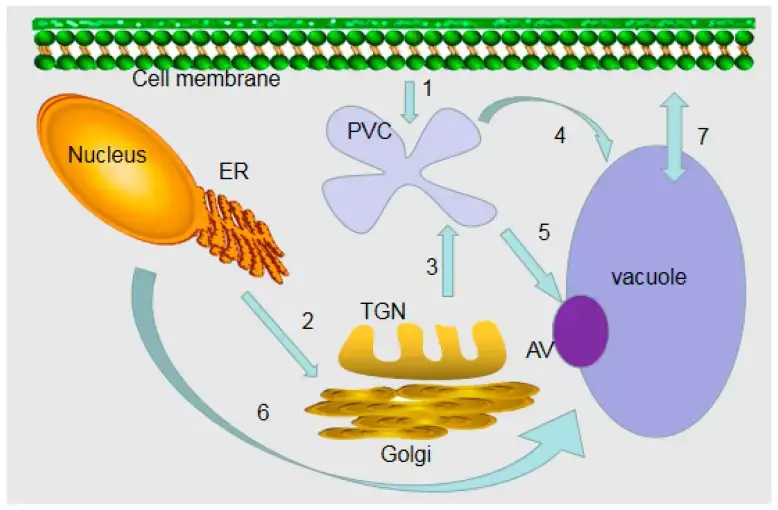
The formation of vacuoles in cells involves various processes that have been studied at both the morphological and molecular levels. Technological advancements, such as metabolomics, proteomics, T-DNA insertion mutants, and heterologous complementation, have significantly contributed to our understanding of vacuole formation.
- Cell Surface Endocytosis to the Prevacuolar Region (PVC): One process involved in vacuole formation is cell surface endocytosis, where substances are taken into the cell through invagination of the cell membrane. These endocytic vesicles move towards the prevacuolar region (PVC), a compartment that precedes the formation of mature vacuoles.
- ER-to-Late Golgi-to-Secretory-Compartment-Transition Pathway: Proteins destined for vacuolar storage are synthesized in the endoplasmic reticulum (ER) and undergo further processing as they move through the Golgi apparatus and secretory compartments before reaching the PVC.
- Early Biosynthetic Vacuolar Route: Some proteins follow an early biosynthetic vacuolar route that directs them to the PVC for storage. The Golgi complex and trans-Golgi network (TGN) play critical roles in guiding these proteins through metabolic pathways.
- Late Biosynthetic Vacuole Route: This route involves transporting proteins from the PVC to the vacuoles. It is a crucial step in the maturation of vacuoles, ensuring that the correct proteins reach their designated storage compartments.
- Degradation or Biosynthetic Routes via Autophagic Vacuoles (AV): Vacuole formation can also involve autophagy, where cellular components are engulfed by autophagic vacuoles and delivered to mature vacuoles for degradation or recycling.
- Direct ER to Vacuole Transport Route: Some proteins are directly transported from the ER to the vacuole, bypassing the Golgi apparatus and secretory compartments.
- Vacuole Membrane Ion and Solute Transport: Once formed, vacuoles are dynamic organelles with membrane transport systems responsible for regulating the flow of ions and solutes into and out of the vacuole, maintaining cellular homeostasis.
In summary, vacuole formation is a complex process involving multiple routes and cellular compartments. Advances in technology have allowed researchers to study vacuoles at the molecular level, providing insights into the intricate mechanisms involved in vacuole biogenesis and function. The various routes and processes ensure that vacuoles perform their essential roles in cellular storage, degradation, and maintaining cellular homeostasis.
Function of vacuoles
- Storage Function: Vacuoles play a crucial role in storing various substances within plant and animal cells. They store pigments like anthocyanin, which impart color to fruits and flowers. Additionally, vacuoles accumulate harmful components in plant cells, isolating them from the cytoplasm. In certain plants, like Hevea brasiliensis and Papaver somniferum, vacuoles store specialized products such as rubber latex and opium, respectively. In seeds, vacuoles are pivotal for storing proteins essential for germination.
- Homeostatic Function: Vacuoles contribute significantly to cellular homeostasis. For instance, they regulate the pH balance within cells by transporting hydrogen ions into the vacuoles, particularly under low environmental pH conditions. This mechanism helps maintain the cell’s internal environment.
- Turgor Pressure: The high fluid content within vacuole sap exerts turgor pressure on the cell wall. This pressure is fundamental in maintaining the cell’s osmotic balance, which is critical for various cellular functions.
- Metabolic Function: In plant cells, vacuoles are involved in metabolic activities. An example is the storage of malic acid in succulent plants, which is later converted into sugars during daylight, aiding in photosynthesis.
- Autophagy: Certain vacuoles participate in autophagy due to their content of hydrolytic enzymes. This process is vital for cellular health, as it leads to the degradation and recycling of cellular components.
- Lysosomal Function: Vacuoles also mirror the functions of lysosomes, particularly in the removal of toxins and waste materials from the cell, thereby contributing to cellular cleanliness and efficiency.
- Structure and Support: In plant cells, vacuoles assist in cell enlargement and provide structural support, contributing to the overall rigidity and integrity of the plant.
- Sequestration of Harmful Substances: Vacuoles are adept at sequestering substances that could be harmful to the cell if present in the cytoplasm in large quantities. This function is vital for the cell’s survival in adverse conditions.
- Homeostasis in Variable Environments: Plant cells rely on vacuoles for maintaining homeostasis amidst environmental fluctuations, such as changes in external pH. Vacuoles adjust their content to buffer these variations, thereby stabilizing the internal cell environment.
- Growth and Germination: By increasing in size, vacuoles facilitate rapid growth in germinating plants or their organs, primarily using water. In seeds, ‘protein bodies’, which are modified vacuoles, store proteins needed for germination.
- Function in Fungal and Animal Cells: In fungal cells, vacuoles are involved in various processes including pH and ion concentration homeostasis, osmoregulation, storage of amino acids, and degradative processes. In animal cells, vacuoles have more subordinate roles, aiding in larger processes of exocytosis and endocytosis.
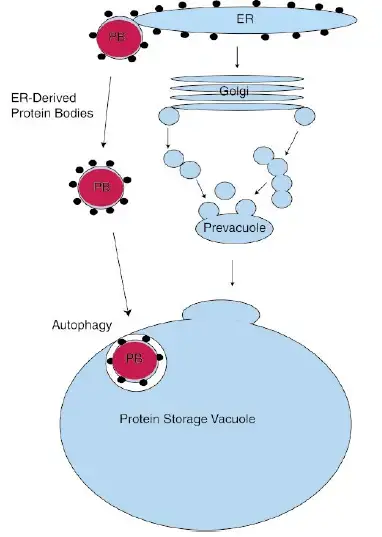
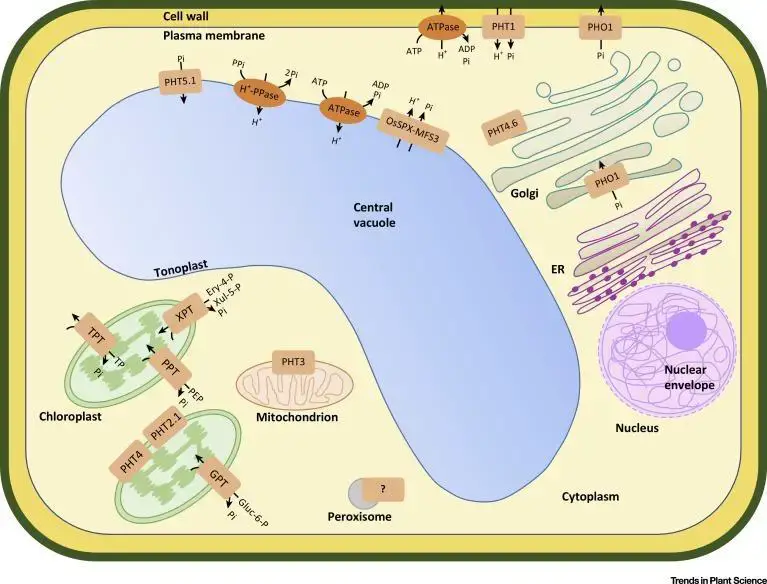

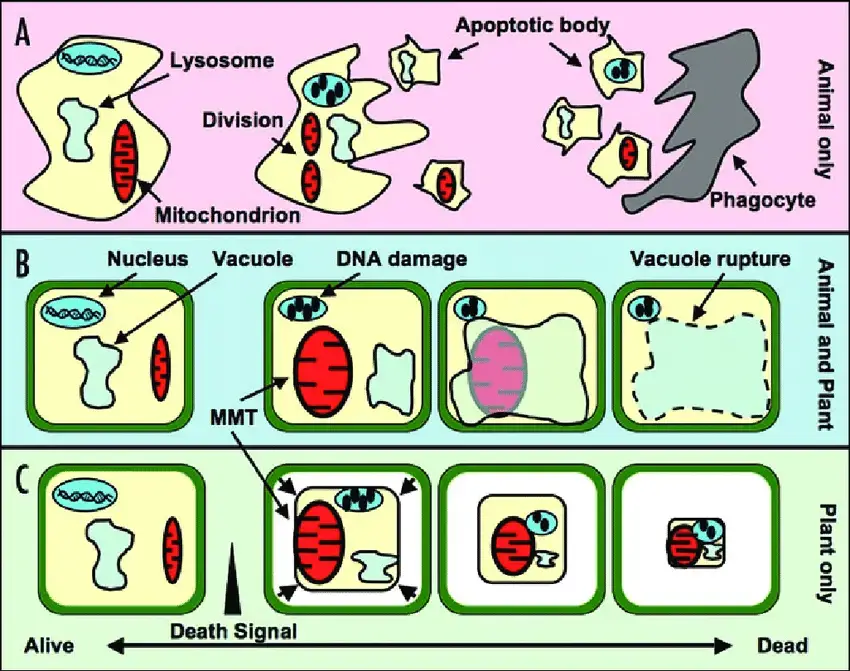
Role of vacuoles in Cell Defence and Cell Death
Vacuoles, as integral components of cellular structure, play a significant role in both cell defense and cell death. Their involvement in these processes is characterized by the release of various substances that contribute to the cell’s immune response and programmed cell death (PCD).
- Role in Cell Defense: Vacuoles contribute to the immunity of cells by releasing hydrolytic enzymes and antimicrobial agents. These substances are instrumental in combating pathogens that invade the cell. The mechanism through which vacuoles facilitate this defense, although not entirely understood, involves the utilization of their contents to neutralize or destroy invading organisms.
- Involvement in Programmed Cell Death (PCD): Programmed cell death, a vital process for maintaining cellular health and homeostasis, is also influenced by vacuoles. During PCD, enzymes known as vacuolar processing enzymes play a crucial role. These enzymes lead to the destruction of the vacuolar membrane, resulting in the collapse of the vacuole. This collapse releases hydrolytic enzymes and other antimicrobial agents into the cell. While this action is effective in destroying invaders, it also contributes to the cell’s own demise as part of the programmed cell death process.
- Vacuole and Plasma Membrane Interactions: In contrast to the above process, another aspect of vacuolar function in cell death involves the interaction between the central part of the vacuole and the plasma membrane. The presence of the proteasome in this interaction may result in the release of antibacterial protease and other vacuolar components. These released substances can lead to cellular destruction. This process underscores the vacuole’s role in the regulatory mechanisms of cell death.
What is Central vacuoles?
Central vacuoles are a prominent feature in the cells of many plants and fungi, serving multiple critical functions.
- Size and Prevalence In mature plant cells, the central vacuole typically occupies more than 30% of the cell’s volume, and in some cells, it can encompass as much as 80%. The cellular cytoplasm in these cells forms numerous strands that traverse the vacuole, reflecting its substantial size.
- Membrane Composition The central vacuole is enclosed by a membrane known as the tonoplast. The term “tonoplast” derives from Greek, indicating its role in “stretching” or “tension”. This membrane separates the vacuolar contents from the cell’s cytoplasm and is primarily involved in controlling the flow of ions within the cell and isolating potentially harmful substances.
- pH Regulation and Electromotive Force Protons are transported from the cytosol to the vacuole, stabilizing the cytoplasm’s pH and making the vacuole’s interior more acidic. This acidic environment enables degradative enzymes to function effectively. The electromotive force generated by this pH gradient allows for efficient nutrient transfer into and out of the vacuole.
- Variation Across Tissues and Development Stages The size and number of vacuoles can vary depending on the tissue type and developmental stage. For example, cells in developing meristems have small provacuoles, while cells in the vascular cambium may have multiple small vacuoles or a single large one, depending on the season.
- Turgor Pressure and Plant Support A crucial function of the central vacuole is maintaining turgor pressure against the cell wall. This pressure is regulated by tonoplast proteins (aquaporins) which control water movement. Potassium ions are actively transported to maintain osmotic balance, leading to water influx and subsequent pressure on the cell walls. Turgor pressure is vital for cell extension and supporting plants in an upright position.
- Chemical Storage and Defense Central vacuoles store various chemicals that, upon cell damage, can react with cytosolic chemicals to produce deterrents against herbivores. For example, in garlic, alliin and the enzyme alliinase are separated in the intact vacuole but form allicin when the vacuole is breached. Similarly, cutting onions triggers a reaction leading to the production of syn-propanethial-S-oxide.
- Role in Fungal Cells In fungal cells, vacuoles perform analogous functions to those in plants. They can be multiple per cell and are involved in cell pH homeostasis, ion regulation, osmoregulation, amino acid storage, and sequestration of toxic ions like strontium, cobalt(II), and lead(II), thereby isolating these from the rest of the cell.
What is Autophagy?
Autophagy is a critical cellular process, particularly in plants, for the removal and recycling of unwanted substances and components within the cell.
- Formation of Autophagosome The process begins with the encapsulation of cellular components that are no longer needed into a vesicle known as an autophagosome. These components within the cytoplasm, varying from proteins to lipids, are isolated from the rest of the cell by the double membrane of the autophagosome.
- Transfer to the Vacuole Once these materials are contained within the autophagosome, they are transported to the vacuole. In the vacuole, these materials undergo degradation. The double membrane of the autophagosome allows it to encapsulate and transport a variety of cytoplasmic materials to the vacuole effectively.
- Recycling of Cellular Components The process of autophagy plays a crucial role in breaking down cell components into their essential constituents, which can then be reused by the cell. For instance, the breakdown of proteins into peptides allows these smaller units to be transported through the endoplasmic reticulum and Golgi apparatus for further processing and utilization.
- Triggered by Various Conditions Autophagy is initiated under various internal and external cellular conditions. Stressful situations, such as starvation, can activate autophagy, leading to the breakdown of different cellular elements, including proteins and lipids, to generate energy and maintain cellular survival.
- Selective Elimination of Components While earlier it was believed that autophagy was a non-selective process, recent research indicates that autophagy can indeed selectively target specific components for elimination. This selective autophagy is particularly evident in yeast cells under certain stress conditions, where specific proteins are targeted for degradation.
Structure and Function of Vacuoles in Animal Cells
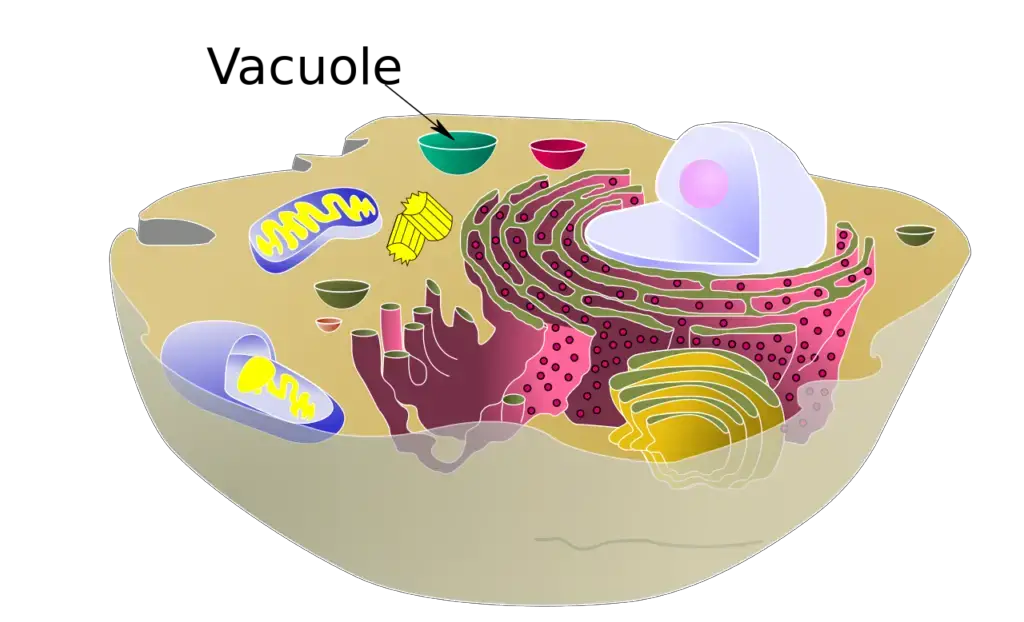
In animal cells, vacuoles exhibit distinct structural and functional characteristics compared to plant cells, playing specific roles mainly in endocytosis and exocytosis.
Structure
- Size and Number Unlike plant cells which typically contain a single large central vacuole, animal cells usually possess many smaller vacuoles. It is also important to note that not all animal cells contain vacuoles, marking a significant difference from plant cells where vacuoles are universally present.
Function of Vacuoles in Animal Cells
- Endocytosis Assistance One of the primary functions of vacuoles in animal cells is to facilitate endocytosis. This process involves engulfing materials from the external environment into the cell. Substances taken into the cell via endocytosis often end up in these vacuoles, where they serve as temporary storage compartments.
- Exocytosis and Storage During exocytosis, vacuoles in animal cells act as reservoirs for various proteins and lipids. These molecules are released from the vacuoles as per the cellular requirements and are then transported outside the cell. Exocytosis is crucial for the secretion of substances like hormones and enzymes.
- Limited Role in Degradation In contrast to plant cells, where vacuoles play a significant role in the degradation of cellular waste, animal cells rely on lysosomes for this purpose. Therefore, vacuoles in animal cells are not primarily responsible for the breakdown of cellular waste or foreign materials.
- Symbiotic Functions In certain specialized organs, some animal cells may contain vacuoles that house symbiotic bacteria. However, this function is restricted to specific cell types and is not a common feature across all animal cells.
Structure and Function of Vacuoles in Plant Cells
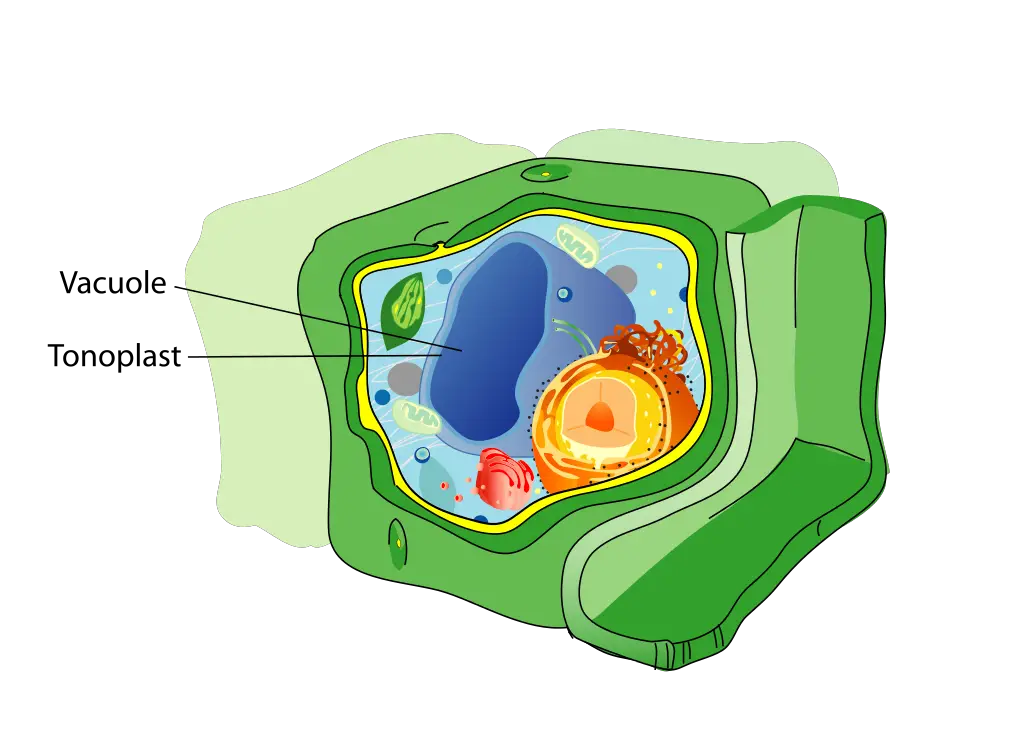
In plant cells, vacuoles are membrane-bound organelles that play pivotal roles in maintaining cellular structure, regulating the internal environment, and managing chemical storage and transport.
Structure
- Size and Composition Vacuoles in plant cells are typically large, often occupying a significant portion of the cell’s volume. In some cells, such as the storage cells of seeds, a vacuole can account for up to 90% of the cell’s volume. The vacuole is enclosed by a single membrane known as the tonoplast, which isolates it from the cytoplasm. This membrane comprises lipids and proteins, including transporters that facilitate the movement of molecules in and out of the vacuole.
- Contents The contents of the vacuole, often referred to as cell sap, include water, ions, organic molecules, and occasionally pigments or crystals. These components are critical for various cellular functions and contribute to the overall osmotic balance within the cell.
Function of Vacuoles in Plant Cells
- Storage As principal storage organelles, vacuoles in plant cells store a wide array of substances, including water, ions, amino acids, carbohydrates, pigments, and toxins. They are also responsible for storing large molecules like carbohydrates and amino acids, as well as waste materials the cell aims to sequester or eliminate.
- Turgor Pressure Vacuoles are crucial in maintaining the shape and rigidity of plant cells through a process known as turgor pressure. They generate this pressure, which is exerted on the cell wall, helping to maintain the cell’s structure and preventing it from collapsing.
- pH Regulation Another significant role of vacuoles is in pH regulation within the plant cell. They can store protons and other ions, maintaining an acidic pH necessary for the activity of many enzymes.
- Detoxification Vacuoles also play a role in detoxification by storing and isolating potentially harmful substances produced within or taken up by the cell. This function is vital for the cell’s health and survival.
- Reproduction In some plant cells, vacuoles are involved in reproductive processes. For example, in pollen cells, the vacuole is essential for regulating the dimensions of the cell as it develops into a pollen grain.
Structure and Function of Vacuoles in Fungal cells
In fungal cells, vacuoles exhibit a structure similar to those in animal cells but their functions align more closely with plant cell vacuoles, particularly in the absence of lysosomes.
Structure
- Vacuolar Shape The vacuoles in fungal cells, including yeast cells, generally mirror the structural characteristics found in animal cells. These include variable shapes and sizes of vacuoles within the cell, which is a contrast to the typically large, central vacuole found in plant cells.
Function of Vacuoles in Fungal Cells
- pH Homeostasis Fungal vacuoles play a crucial role in maintaining the pH balance within the cell. This function is important for ensuring the optimal environment for various cellular processes and enzyme activities.
- Ion Concentration and Enrichment Vacuoles in fungal cells are involved in the concentration and enrichment of ions. This process is vital for maintaining the cell’s ionic balance and ensuring proper functioning.
- Osmoregulation Osmoregulation, the control of water balance within the cell, is another key function of vacuoles in fungal cells. This is essential for maintaining cell integrity and preventing damage from osmotic stress.
- Storage of Amino Acids and Polyphosphates These vacuoles also serve as storage sites for amino acids and polyphosphates. The storage of these compounds is crucial for various metabolic processes within the cell.
- Degradation Processes Similar to plant vacuoles, fungal vacuoles are involved in degradation processes. They break down various cellular components, thereby playing a role in recycling and waste management within the cell.
- Storing Hazardous Ions Fungal vacuoles have the capacity to store hazardous ions, such as strontium (Sr2+) and lead (Pb2+). This function is critical in protecting the cell from potential toxicity and maintaining cellular health.
Structure and Function of Vacuoles in Bacteria Cells
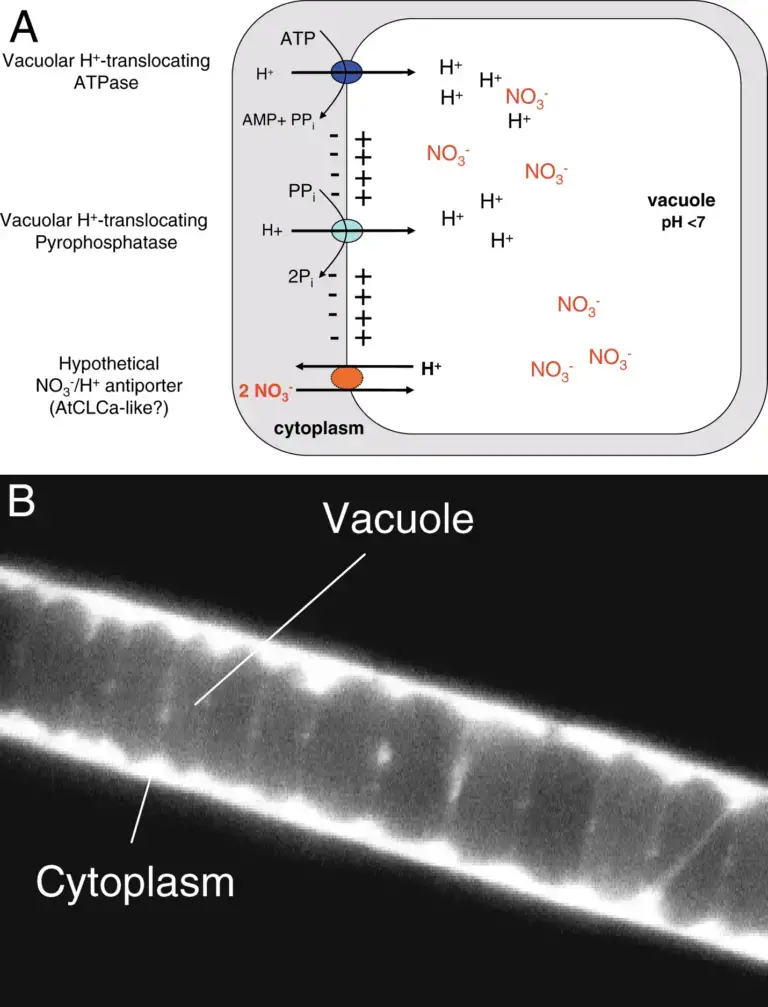
In bacterial cells, vacuoles present a unique structure and serve specialized functions that differ significantly from those in plant cells.
Structure
- Formation Bacterial vacuoles are formed by the invagination of the cell membrane. This process results in the creation of tiny spherical structures within the cytoplasm.
- Membrane Enclosure Each vacuole in a bacterial cell is enclosed by a single membrane. This membrane separates the vacuole’s contents from the rest of the cytoplasm, effectively compartmentalizing various substances within the cell.
- Content Storage Bacterial vacuoles are versatile in terms of their storage capacity. They can house a range of substances, including gases, liquids, and nutrients, which are vital for the bacteria’s survival and metabolic functions.
Function of Vacuoles in Bacteria Cells
- Nutrient Storage Vacuoles in bacteria cells play a critical role in storing essential nutrients such as carbon and nitrogen. This storage is particularly important for bacterial survival and growth, especially during times of nutrient scarcity. The vacuoles allow bacteria to access these stored nutrients when external sources are limited.
- Waste Management In some bacteria, particularly those involved in wastewater treatment, vacuoles are utilized for storing waste products like ammonia and nitrogen. These vacuoles can also facilitate the secretion of these toxins outside of the cell, thereby protecting the bacteria from potential harm caused by these waste products.
- Protection Against Harsh Environments Vacuoles offer a mechanism for some bacteria to store water, which is crucial for survival in environments with high salt concentrations. This storage aids in the regulation of the cell’s internal water content, helping the bacteria to maintain homeostasis under stressful conditions.
- Gas Storage for Metabolic Processes Certain bacteria have the ability to store gases, such as oxygen and nitrogen, in their vacuoles. This storage is utilized for various metabolic operations as and when these gases are needed.
Structure and Function of Vacuoles in Protist Cells
Protists, a diverse group of single-celled organisms, possess vacuoles with a variety of structures and functions tailored to their specific needs and environmental conditions.
Structure of Vacuoles in Protist Cells
- Membrane-Bound Organelles Similar to plant cells, vacuoles in protist cells are enclosed by a membrane known as the tonoplast. This membrane serves to separate the vacuole’s contents from the cytoplasm, ensuring compartmentalization within the cell.
- Variability in Size, Shape, and Number The size, shape, and number of vacuoles in protist cells can vary significantly across different types of protists. This variability reflects the diverse nature of protists and their adaptation to various environments.
Function of Vacuoles in Protist Cells
- Nutrient Storage Protist vacuoles often store essential nutrients, including food particles and enzymes. This storage is crucial for the survival and growth of the cell, particularly in nutrient-scarce environments.
- Waste Storage These vacuoles also function as compartments for the accumulation and storage of waste products. This includes excess water, ions, and other molecules that need to be removed from the cell to maintain cellular health.
- Osmoregulation In certain protists, vacuoles play a pivotal role in osmoregulation – the regulation of ion concentrations and water balance within the cell. This function is crucial for maintaining cellular integrity and function, especially in fluctuating environmental conditions.
- Contractile Vacuoles Some protists have specialized contractile vacuoles, which are essential for expelling excess water from the cell. This mechanism is particularly important for protists in freshwater environments, where there is a constant risk of water influx due to osmotic pressure.
- Gas Exchange For protists living in aquatic environments, vacuoles can be involved in gas exchange processes, facilitating the exchange of gases like oxygen and carbon dioxide with the surrounding water. This function is vital for respiration and metabolic activities in these organisms.
Microscopy of Vacuoles
Microscopy of vacuoles involves staining techniques to visualize and study the structure of these organelles under a light microscope. While vacuoles do not stain easily due to their limited stainable constituents, experiments have demonstrated that it is possible to stain them by using colored dyes that are taken up and accumulated by the sap inside the vacuoles.
Various basic dyes can be used for staining vacuoles, with the specific pH level of the dye depending on the type of vacuole being targeted. Some common dyes used for this purpose include Neutral red, Brilliant cresyl blue, Methylene blue, and Pyronin. In this discussion, we will focus on the staining technique using Neutral red solution with a pH below 6.0.
Requirements:
- A part of a plant (e.g., roots, leaves)
- Neutral red stain (dissolved in 0.08M phosphate buffer with a pH of 7.2)
- Distilled water
- Compound light microscope
- Glass slides and cover slips
- Droppers
- Tweezers
Procedure:
- Obtain a thin sample of the plant, such as a small section of the root or leaf, using a pair of forceps.
- Stain the sample with a 0.01 percent solution of Neutral red, ensuring that the dye penetrates the cells.
- Rinse the stained sample with the phosphate buffer to remove any excess dye.
- Mount the sample on a glass slide with a cover slip for observation under the microscope.
Observation:
By following this staining procedure, the Neutral red dye will specifically stain the vacuoles of live plant cells while leaving other organelles unstained. When viewed under the microscope, the vacuoles will appear deep red in color, making them clearly visible for further analysis and study.
Microscopy of vacuoles using staining techniques provides valuable insights into the structure and distribution of these essential organelles within plant cells. It allows researchers and students to study the functions and characteristics of vacuoles, which play vital roles in nutrient storage, waste management, and cell turgor pressure regulation in plants.
Compare the role of vacuoles and lysosomes in a cell
Vacuoles and lysosomes are both organelles found within cells, but they serve different roles and functions.
- Role in Storage:
- Vacuoles: Vacuoles are primarily responsible for storage in plant cells. They store various substances such as water, nutrients, ions, sugars, pigments, and waste products. Vacuoles in plant cells can occupy a large portion of the cell’s volume and are crucial for maintaining turgor pressure and providing structural support to the plant.
- Lysosomes: Lysosomes, on the other hand, are involved in intracellular digestion and waste disposal in animal cells. They contain hydrolytic enzymes that can break down various biological molecules, including proteins, lipids, carbohydrates, and nucleic acids. Lysosomes function as the cell’s recycling centers, breaking down damaged organelles and cellular debris, and digesting material taken up through endocytosis.
- Role in Digestion:
- Vacuoles: Some specialized vacuoles, known as food vacuoles, are involved in the digestion of food particles in certain protists. These vacuoles fuse with lysosomes-like structures to break down ingested material.
- Lysosomes: Lysosomes are the primary organelles involved in intracellular digestion. They contain various hydrolytic enzymes that work at an acidic pH to break down complex molecules into simpler ones, which can then be used by the cell.
- Role in Cellular Defense:
- Vacuoles: Some plant vacuoles store toxic compounds and secondary metabolites that act as chemical defenses against herbivores and pathogens. These toxic substances can be released when needed to protect the plant.
- Lysosomes: Lysosomes play a role in cellular defense by degrading and destroying invading bacteria and other foreign materials through a process called phagocytosis.
- Role in Cell Homeostasis:
- Vacuoles: Plant vacuoles are essential for maintaining cell homeostasis by regulating the concentration of ions and other solutes within the cell. They contribute to osmoregulation and control the movement of water across the cell membrane, helping the cell maintain its shape and turgor pressure.
- Lysosomes: Lysosomes help maintain cell homeostasis by degrading and recycling cellular components, ensuring the removal of damaged or unnecessary materials from the cell.
Quiz
What is the primary function of vacuoles in plant cells?
a) Protein synthesis
b) DNA replication
c) Storage of waste products
d) Energy production
In which type of cells are vacuoles generally larger?
a) Animal cells
b) Bacterial cells
c) Fungal cells
d) Plant cells
What substance is primarily stored in the central vacuole of plant cells?
a) Protein
b) DNA
c) Water
d) Lipids
Contractile vacuoles are primarily involved in:
a) Storing food
b) Osmoregulation
c) DNA replication
d) Energy production
Which organelle is often associated with the formation of vacuoles in animal cells?
a) Mitochondria
b) Golgi apparatus
c) Nucleus
d) Ribosomes
Vacuoles in plant cells are bound by a single membrane called:
a) Plasmalemma
b) Tonoplast
c) Chloroplast
d) Endoplasmic reticulum
Which of the following is NOT a function of vacuoles in cells?
a) Storing nutrients
b) Maintaining cell shape
c) Assisting in cell division
d) Producing ATP
In protozoa, the contractile vacuole is responsible for:
a) Digestion
b) Excretion
c) Respiration
d) Reproduction
In fungi, vacuoles are involved in:
a) Photosynthesis
b) Osmoregulation
c) Movement
d) Respiration
Which of the following cells typically lacks a vacuole?
a) Yeast cell
b) Bacterial cell
c) Plant cell
d) Amoeba
FAQ
What is a vacuole?
A vacuole is a membrane-bound organelle found in cells that can store various substances, including water, enzymes, and waste products.
What is the function of a vacuole?
The function of a vacuole can vary depending on the type of cell and the organism it belongs to. Generally, vacuoles can store and regulate the concentrations of substances, such as ions and nutrients, within a cell. They can also play a role in cellular digestion, waste management, and cell growth.
What types of organisms have vacuoles?
Vacuoles are found in both plant and animal cells, as well as in many single-celled organisms.
How do vacuoles differ in plant and animal cells?
In plant cells, vacuoles are typically larger and more prominent than in animal cells. Plant vacuoles can occupy up to 90% of a cell’s volume and play a crucial role in maintaining the plant’s structure, turgor pressure, and nutrient storage. In animal cells, vacuoles are usually smaller and less prominent, and they may have different functions depending on the cell type.
Can vacuoles change in size and shape?
Yes, vacuoles can change in size and shape depending on the cell’s needs. For example, if a cell needs to store more water, the vacuole may expand to accommodate it.
How are vacuoles formed?
Vacuoles are formed from membrane vesicles that originate from the Golgi apparatus or the endoplasmic reticulum. These vesicles can fuse with existing vacuoles or with the plasma membrane to form new vacuoles.
What is the pH of a vacuole?
The pH of a vacuole can vary depending on the cell type and the function of the vacuole. For example, the vacuoles in plant cells can have an acidic pH to aid in the breakdown of proteins during digestion.
Can vacuoles be used for energy storage?
Yes, some vacuoles can be used for energy storage in the form of starch or other organic molecules. In plant cells, for example, the central vacuole can store starch for later use.
How do vacuoles contribute to the health of a cell?
Vacuoles play a crucial role in maintaining the overall health and function of a cell by regulating the internal environment, removing waste products, and storing essential nutrients.
Can vacuoles be targeted for medical purposes?
Yes, vacuoles have been targeted for medical purposes in various studies. For example, researchers have explored using drugs that target vacuoles to treat parasitic infections, cancer, and other diseases.
References
- Stefan, C. J., Henne, W. M., & Emr, S. D. (2013). Vacuoles. Encyclopedia of Biological Chemistry, 502–508. doi:10.1016/b978-0-12-378630-2.00441-2
- Francis Marty, Plant Vacuoles, The Plant Cell, Volume 11, Issue 4, April 1999, Pages 587–599, https://doi.org/10.1105/tpc.11.4.587
- Tan X, Li K, Wang Z, Zhu K, Tan X, Cao J. A Review of Plant Vacuoles: Formation, Located Proteins, and Functions. Plants (Basel). 2019 Sep 5;8(9):327. doi: 10.3390/plants8090327. PMID: 31491897; PMCID: PMC6783984.
- http://www.biology4kids.com/files/cell_vacuole.htmlhttps://bscb.org/learning-resources/softcell-e-learning/vacuole-plants/
- https://blog.prepscholar.com/vacuole-function-definition
- https://www.geeksforgeeks.org/vacuoles/
- https://www.dictionary.com/browse/vacuole
- https://www.cell.com/current-biology/pdf/S0960-9822(14)01550-4.pdf
- https://academic.oup.com/plcell/article/11/4/587/6008435
- https://en.wikipedia.org/wiki/Vacuole
- https://www.biologyonline.com/dictionary/vacuole
- Text Highlighting: Select any text in the post content to highlight it
- Text Annotation: Select text and add comments with annotations
- Comment Management: Edit or delete your own comments
- Highlight Management: Remove your own highlights
How to use: Simply select any text in the post content above, and you'll see annotation options. Login here or create an account to get started.